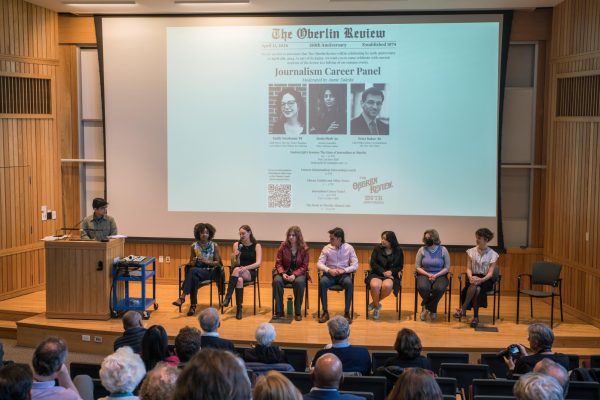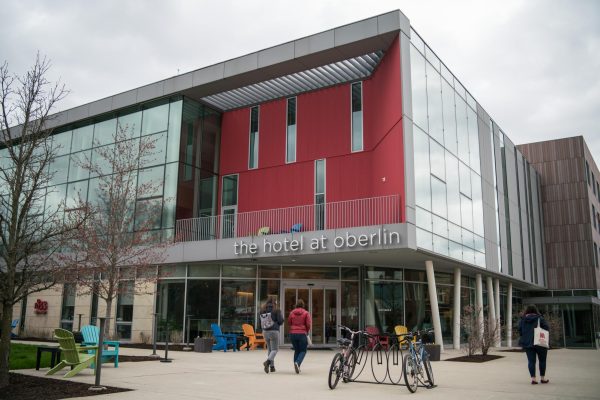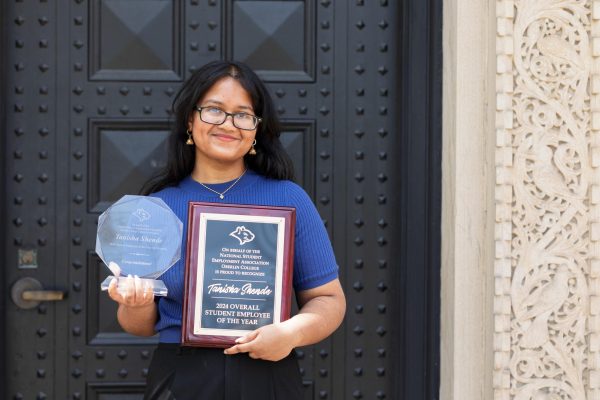Admissions, Communications Present on Applicant Data
Vice President of Communications Ben Jones, OC ’96, and Vice President and Dean of Admissions and Financial Aid Manuel Carballo held a talk for College and Conservatory faculty and select administrative and professional staff Wednesday called “Understanding Oberlin’s Applicants (and Their Understanding of Oberlin).” The talk provided information about the demographic breakdown of Oberlin’s prospective and matriculated students and their reasons for attending or not attending Oberlin.
The discussion was intended to lay the groundwork for the upcoming Administrative and Academic Program Review recommendations, which will be released next week, in hopes that constituencies might better understand the 31-person steering committee’s decisions. All of the data for Jones and Carballo’s talk were collected through two independent research firms, Human Capital Research Corporation and Generation Research Group.
“This presentation was really just a way to show some of the research that has fed into some of the things that the AAPR steering committee is thinking about,” said Jones, who is a member of the AAPR steering committee. “Obviously, we’re all here for the students, and so what the students are thinking about — both prospective, current, and otherwise — is critically important to the future of the College.”
The Office of Admissions and Financial Aid used HCRC, an education research consultant, to conduct an in-depth analysis of why matriculating students come to Oberlin, why some admitted students choose not to attend, where students go instead of Oberlin, how Oberlin is perceived compared to its peers, and more. While the Admissions Office collects matriculation data each year, this is the most comprehensive study they have conducted in recent memory.
“So they do things like help us with choosing a number of students we should take,” Carballo said. “They do some complex econometrics modeling around decision-making. We might take the same number of students one year to the next, but they look beyond [that] to see, ‘What was the academic quality? What is their income level?’ All these other things that would then feed to say, ‘Are you in good shape? Are you over-admitting or under-admitting?’”
Much of the data will have significant ramifications for how Oberlin is presented to prospective students moving forward.
For instance, many prospective students perceive Oberlin as having inferior internship and career opportunities compared to many peer institutions. This, along with Oberlin’s hefty pricetag, suggests that Oberlin is seen to have an inordinately low value proposition. This has been exacerbated by critical media coverage, such as a 2010 Business Insider article which claimed Oberlin provided the worst return on investment of any college in the U.S.
This value proposition is becoming increasingly important as the number of families who are able to afford full tuition steadily shrinks nationwide. While Oberlin isn’t need-blind, the school does meet 100 percent of demonstrated financial need for its accepted students. Because of this, 40 percent of College students and 60 percent of Conservatory students do not pay full tuition costs.
The data also indicate that Oberlin’s location is a turnoff for some students, who don’t anticipate finding many internship or career opportunities in rural Ohio.
Finally, Oberlin’s community was deemed polarizing for many students, as some fit in extremely well and others not at all, with less middle ground than at similar schools.
Along with the work happening in Admissions, the Office of Communications contracted the Generation Project, a New York-based branding and communications agency. While the data that Generation gathered are relevant for AAPR, the Office of Communications has been in the process of gathering this information since fall of 2017, long before the AAPR was assembled. The last in-depth study about Oberlin’s national and internal reputation was conducted in 2006.
The research’s main focus was questions about how Oberlin is perceived on the national stage, what Oberlin students value most about their education, and the perceived value and uses of an Oberlin degree.
One of the key takeaways is that, while Oberlin is seen as a top academic institution nationally, it is primarily associated with progressivism and politics, which deters some prospective students who are interested in academics over activism.
“I’m proud of Oberlin’s history, and it’s cool to see that people out there are proud of it too, but I do think that the main liability is when our commitment to social justice and activism gets totally decoupled from our academic excellence,” Jones said. “If people start thinking that Oberlin is only about social justice and not about academic excellence, then they lose the point of Oberlin, which is the education itself. That propels the world forward because people take their education and they go do extraordinary things with it in the name of progress.”
Additionally, researchers found Oberlin is seen as a great institution for people interested in more creative or academic professions — catering to activists, professors, social workers, or artists — it’s not perceived as a good fit for people with entrepreneurial or STEM interests, such as prospective doctors, engineers, CEOs, lawyers, and finance executives.
The study also found that professional training opportunities are becoming a priority for prospective college students, and was a major factor for students who were accepted but chose not to attend Oberlin. Meanwhile, matriculated Oberlin students tend to value professional training less and see the College as an opportunity to explore their “mind, values, and identity,” according to the presentation.
Carballo and Jones put this data into the context of national high school graduation rates, which are projected to steeply decline beginning in 2026. Additionally, studies show that the Northeast and Midwest — two of Oberlin’s largest demographic contributors — are going to start seeing significant declines in the populations of young people in the coming years.
According to Carballo, this means that the college admissions process is going to get a lot more competitive between schools in terms of attracting potential students — especially among small liberal arts schools like Oberlin.
For some faculty in attendance, the talk provided a useful look into what kinds of data AAPR steering committee members are looking at.
“Personally, it gave me confidence that we are now proceeding with intentionality to recruit and retain the kind of bright, community-engaged Oberlin students that we have always treasured,” said Professor of Politics Eve Sandberg. “It did highlight, however, that many of the things we already do well are not being conveyed to our applicants.”
Although the presentation wasn’t directly open to students, Jones said that they will consider making the data and information available to students after the offices have a chance to more thoroughly review the implications.




